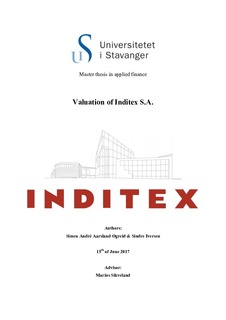| dc.contributor.advisor | Marius, Sikveland | |
| dc.contributor.author | Øgreid, Simen Andre Aarsland | |
| dc.contributor.author | Iversen, Sindre | |
| dc.date.accessioned | 2017-09-27T11:48:09Z | |
| dc.date.available | 2017-09-27T11:48:09Z | |
| dc.date.issued | 2017-06 | |
| dc.identifier.uri | http://hdl.handle.net/11250/2457069 | |
| dc.description | Master's thesis in Finance | nb_NO |
| dc.description.abstract | The purpose of this master thesis is to determine the fair value of a share in the Spanish multinational apparel retailer Inditex, compared to the closing market price 15th of March 2017. The equity value will be calculated using a discounted cash flow model (DCF), and complemented by a Monte Carlo simulation and a relative valuation.
Financial figures for the DCF model are forecasted based on strategic and financial analyses. The strategic analysis uncovers Inditex’s unique position in the apparel industry, being the first apparel company to successfully compete on time-to-market. By owning the whole value chain and using a large distribution center in Spain, they can produce new design in rapid speeds and have new apparel delivered to stores in as little as two weeks. Although this model has resulted in immense growth, the market is catching up and starting to copy their fast fashion model, leading to a fragmented market. In addition, fashion consumers are demanding more personalized apparel and larger focus on sustainability. These facts could negatively influence Inditex’s growth and margins.
The financial analysis uncovered a solid company, that has been able to leverage its growth by leasing stores, giving the illusion that it’s an asset light company. This has resulted in a 10-year average ROIC of 28%. In addition, all cost margins have been impressively stable in the analyzed period, where sales have grown from €9bn in 2007 to €23bn in 2016. These facts complement why we expect Inditex to keep on growing. However, margins have been slightly decreasing the latest two years, an effect also seen in peer companies which is in line with the fragmentation of the market witnessed in the strategic analysis.
Based on these two analyses, the free cash flows for the next 10 years were forecasted. WACC was estimated to 8,39%. The DCF model uncovered a fair share value of €28,69. On 15th of March 2017, the last Inditex shares changed hands on Bolsa de Madrid at €31,41, implying that the market is overestimating its equity value by 8,7% compared to the DCF model. The same effect was found from the Monte Carlo simulation and multiple analysis, supporting the DCF model. We conclude that the market has not taken the increased competition and margin pressure into effect. | nb_NO |
| dc.language.iso | eng | nb_NO |
| dc.publisher | University of Stavanger, Norway | nb_NO |
| dc.relation.ispartofseries | Masteroppgave/UIS-SV-HH/2017; | |
| dc.rights | Navngivelse 4.0 Internasjonal | * |
| dc.rights | Navngivelse 4.0 Internasjonal | * |
| dc.rights.uri | http://creativecommons.org/licenses/by/4.0/deed.no | * |
| dc.subject | økonomi | nb_NO |
| dc.subject | administrasjon | nb_NO |
| dc.subject | Inditex | nb_NO |
| dc.subject | valuation | nb_NO |
| dc.subject | verdsettelse | nb_NO |
| dc.subject | business | nb_NO |
| dc.subject | administration | nb_NO |
| dc.subject | finans | nb_NO |
| dc.title | Valuation of Inditex S.A. | nb_NO |
| dc.type | Master thesis | nb_NO |
| dc.subject.nsi | VDP::Samfunnsvitenskap: 200::Økonomi: 210 | nb_NO |

